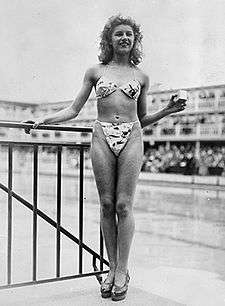Bikini variants

The bikini has spawned many stylistic variations. A regular bikini is a two-piece swimsuit that together covers a female's crotch, buttocks, and breasts. Some bikini designs cover larger portions of the wearer's body while other designs provide minimal coverage. Topless variants are still sometimes considered bikinis, although they are technically not a two-piece swimsuit.[1]
Terminology
While the name bikini was applied to the skimpy fashion that first revealed the wearer's navel, the fashion industry considers any two-piece swimsuit a bikini.[2] Modern bikini fashions today are characterized by a simple, brief design: two triangles of fabric that form a bra and cover the woman's breasts and two triangles of fabric on the bottom forming a panty cut below the navel[3] that cover the groin in front and the buttocks in back.[3] The amount of coverage can vary widely, from a string bikini with very little coverage to a full design with maximum coverage. A topless swimsuit may still be considered a bikini, although naturally it is no longer a two-piece swimsuit.[1]
These derivations of the word bikini were created through inappropriate analogy with words like bilingual, bifocal and bilateral, which contain the Latin prefix "bi-" (meaning "two" in Latin), the word bikini was first back-derived as consisting of two parts, [bi + kini] by Rudi Gernreich when he designed the monokini in 1964.[4] Later swimsuit designs like the tankini and trikini were also named based on the erroneous assumption that the "bi-" in bikini denotes a two-piece swimsuit.[5] These new coinages falsely presumed that the back-formation [bi + kini] was purposeful.[6][7]
The "-kini family" (as dubbed by author William Safire[8]), including the "-ini sisters" (as dubbed by designer Anne Cole[9]) has grown to include a large number of subsequent variations, often with a hilarious lexicon.[10] Major stylistic variations and an array of spinoff styles include string bikini, monokini or numokini (single, top part missing), tankini (tank top, bikini bottom), camikini (camisole top and bikini bottom), hikini or hipkini, thong, slingshot or sling bikini (actually a one-piece swimsuit), minimini, teardrop, seekini (transparent bikini), microkini and granny bikini (bikini top and boy shorts bottom).[10][11][11][12] In just one major fashion show in 1985, there were two-piece suits with cropped tank tops instead of the usual skimpy bandeaux, suits that are bikinis in front and one-piece behind, suspender straps, ruffles, and daring, navel-baring cutouts.[13]
Variants
String bikini

A string bikini is scantier and more revealing than a regular bikini. It gets its name from the string characteristics of its design. It consists of two triangular shaped pieces connected at the groin but not at the sides, where a thin "string" wraps around the waist connecting the two parts. String bikini tops are similar and are tied in place by the attached "string" pieces. String pieces can either be continuous or tied. A string bikini bottom can have minimal to maximum coverage of a woman's backside.
It is claimed that Brazilian fashion model Rose de Primallio created the first string bikini when she had to sew one with insufficient fabric available to her for a photoshoot. The first formal presentation of string bikini was done by Glen Tororich, a public relations agent, and his wife Brandi Perret-DuJon, a fashion model, for the opening of Le Petite Centre, a shopping area in the French Quarter of the New Orleans, Louisiana in 1974. Inspired by a picture of a Rio de Janeiro fashion model in an issue of Women's Wear Daily, they had local fashion designer Lapin create a string bikini for the event. Models recruited by talent agent Peter Dasigner presented it by removing fur coats by Alberto Lemon on stage. The presentation was covered by local television stations and the New Orleans Times-Picayune newspaper, and was sent out via the wire news services of the Associated Press and United Press International.
String bikinis are one of the most popular variations of bikini.[14] Bikinis are also worn at the hips, but the fabric at the sides is narrower. In the string bikini, it disappears altogether to leave the waistband as a "string". The rear coverage of the bikini is not as full as with the brief. Bikini is the most widely worn style among women worldwide.[15]
Monokini

A monokini, more commonly referred to as a topless swimsuit and sometimes referred to as a unikini, is a women's one-piece swimsuit equivalent to the lower half of a bikini.[16][17][18] In 1964, Rudi Gernreich, an Austrian fashion designer, designed the original monokini in the US.[19] Gernreich also invented its name, and the word monokini is first recorded in English that year. Gernreich's monokini looked like a one-piece swimsuit suspended from two halter straps in the cleavage of bared breasts. It had only two small straps over the shoulders, leaving the breasts bare. Despite the reaction of fashion critics and church officials, shoppers purchased the monokini in record numbers that summer, though very few monokinis were ever worn in public. By the end of the season, Gernreich had sold 3000 swimsuits at $24 apiece, which meant a tidy profit for such a minuscule amount of fabric.[20] It was not very successful in the USA, where although allowing the sexes equal exposure above the waist, have never accepted it for the beach.[21] Many women who wanted to sunbathe topless simply wore the bottom part of a bikini. Manufacturers and retailers quickly adapted to selling tops and bottoms separately. Gernreich later created the lesser known pubikini.[22]
Peggy Moffitt modeled the suit for Gernreich. She said it was a logical evolution of Gernreich's avant-garde ideas in swimwear design as much as a scandalous symbol of the permissive society.[21] In the 1960s, the monokini led the way into the sexual revolution by emphasizing a woman's personal freedom of dress, even when her attire was provocative and exposed more skin than had been the norm during the more conservative 1950s. Like all swimsuits, the monokini bottom portion of the swimsuit can vary in cut. Some have g-string style backs, while others provide full coverage of the rear. The bottom of the monokini may be high cut, reaching to the waist, with high cut legs, or may be a much lower cut, exposing the belly button. The modern monokini, which is less racy than Gernreich's original design, takes its design from the bikini, and is also described as "more of a cut-out one-piece swimsuit,"[23] with designers using fabric, mesh, chain, or other materials to link the top and bottom sections together, though the appearance may not be functional, but rather only aesthetic.[24] In recent years, the term has come into use for topless bathing by women: where the bikini has two parts, the monokini is the lower part. Where monokinis are in use, the word bikini may jokingly refer to a two-piece outfit consisting of a monokini and a sun hat.[25] The original monokini is still sold by Victoria's Secret as a half-kini.[26]
Microkini
A microkini is an extremely skimpy bikini.[27] The designs for both women and men typically use only enough fabric to cover the genitals. Any additional straps are merely to keep the garment attached to the wearer's body. Some variations of the microkini use adhesive or wire to hold the fabric in place over the genitals. These designs do not require any additional side straps to keep the garment in place. The most radical variations of the microkini are simply thin straps which cover little or none of the wearer's body. The term "microkini" was coined in 1995 in an online community dedicated to enthusiasts of the extreme designs . Microkinis keep the wearer just within legal limits of decency and fill a niche between nudism and conservative swimwear. In Europe it's often allowed to wear the microkinis at the beach or hotel or public pools.[28]
Tankini
_(6793974903).jpg)
The tankini is a swimsuit combining a tank top, mostly made of spandex-and-cotton or Lycra-and-nylon, and a bikini bottom introduced in the late 1990s.[29][30][31] According to author William Safire, "The most recent evolution of the -kini family is the tankini, a cropped tank top supported by spaghetti-like strings."[32] The tankini is distinguished from the classic bikini by the difference in tops, the top of the tankini essentially being a tank top. The tankini top extends downward to somewhere between just above the navel and the top of the hips. The word is a neologism combining the tank of tank top with the end of the word bikini. This go-between nature of tankini has rendered its name to things ranging from a lemonade-based martini (Tankini Martini)[33] to server architecture (Tankini HipThread).[34] This type of swimwear is considered by some to provide modesty closer to that of a one piece suit but with the convenience of a two piece suit, such as not needing to remove the entire suit in order to use a lavatory.
Designer Anne Cole, described as a godmother of swimwear in the USA, was originator of this style.[35] She scored what would be her biggest hit in 1998 when her label introduced the tankini. A two-piece suit with a top half that covered more of a woman's torso than a standard bikini top, the suit was an instant hit with customers.[36] Variations of the tankini, made of spandex-and-cotton or Lycra-and-nylon, have been named camkini, with spaghetti straps instead of tank-shaped straps over a bikini bottom, and even bandeaukini, with a bandeau worn as the top.[35] Tankinis come in a variety of styles, colors and shapes, some include features such as integrated push-up bras. It is particularly popular as children's beachwear,[37] and athletic outfit good enough for a triathlon.[38] According to Katherine Betts, Vogue's fashion-news director, this amphibious sportswear for sand or sea lets the user go rafting, playing volleyball and swimming without worrying about losing their top.[30]
Trikini

The trikini appeared briefly in 1967, defined as "a handkerchief and two small saucers." It reappeared a few years ago as a bikini bottom with a stringed halter of two triangular pieces of cloth covering the breasts.[39] The trikini top comes essentially in two separate parts.[40] The name of this woman's bathing suit is formed from bikini, replacing "bi-", meaning "two", with "tri-", meaning "three".[41] Writer William Safire wrote in The New York Times: "Stripping to essentials, if the trikini is three pieces, the bikini two and the monokini one, when will we see the zerokini?"[42] Dolce & Gabbana designed trikinis for Summer 2005 as three pieces of scintillating fabric that barely cover the wearer.[43] A variation on the bikini in which three pieces are sold together, such as a bikini with a tank top or a bikini with a one-piece suit is also sometimes called a Trikini,[44] including a conventional two-piece with a glitzy band of rhinestones round the waist.[45] Israeli designer Gideon Oberson, known for his artistically inspired bathing suits, calls a two-piece suit but looks like a tank top that can be worn with a skirt or a pair of shorts designed by him a trikini.[46] Brazilian designer Amir Slama calls two scraps of silk connected with string he designed for skinny women a trikini.[47] A variation called a strapless bikini[48] or a no string bikini[49] by various manufacturers, this swimwear is often a combination of pasties with a matching maebari-style bottom.
Sling bikini

The sling bikini is also known as a "suspender bikini", "suspender thong", "slingshot bikini" or just "slingshot". It is a one-piece suit which provides as little, or even less, coverage (or as much exposure) as a bikini. Usually, a slingshot resembles a bikini bottom, but rather than the straps going around the hips or waist, the side straps extend upwards to cover the breasts and go over the shoulders, leaving the entire sides of the torso uncovered, but the nipples and pubic area covered. Behind the neck, the straps join and reach down the back to become a thong.[50] The variation of sling bikinis that has the straps simply encircle the neck and another set of straps pass around the midriff, instead of the straps passing over the neck and down the back, is called a pretzel bikini.[50] Corresponding to the advent of Lycra, these bikinis first emerged in the early 1990s, and is more popular on the beaches of Europe including Saint Tropez, Marabella, Mykonos and Ibiza.[51] Suspender-like straps that running between the breasts and around the neck held the suit up were introduced in the mainstream in 1994. News reports said that within a week of putting the suit on their racks, New York's major stores had sold 150. San Francisco women turned deaf ears to clergymen's warnings that "nakedness and paganism go hand in hand." By season's end, the tally sold was 3000 plus, at $24 a suit.[52]
Bandeaukini

A bandeaukini, alternatively called a bandini,[53] is a bandeau top, with no straps going over the shoulders, worn with any bikini bottom.[35][54]
The appeal of the bandeau grew fast among young women,[55] with bandeau tops edging into the sales of the classic tankini.[56] Sometimes the same design has been called a bandeaukini and a tankini.[35]
A bandeau may be fastened in the front or back or be sufficiently elastic so as not to need a fastener at all. A bandeau may come with a detachable halter strap, for extra support. A strapless bandeau, or tube top, was also worn as casual wear and sports wear starting in the 1970s, and is sometimes worn as part of a sportswear ensemble.[57] Actress Halle Berry wore a skimpy bikini top with matching pants to the MTV Video Music Award, fueling the trend of wearing a bandeau top as an out-of-home dress.[58]
Skirtini
.jpg)
The skirtini, which features a bikini top and a small, skirted bottom, is an innovation for bikini-style clothes with more coverage.[59] In 2007, skirtinis by Juicy Couture were dubbed as one of the top new trends.[60][61] In 2011, The Daily Telegraph identified the skirted bikini as one of the top 10 swimwear design of the season.[62]
According to Anne-Marie Blondeau, marketing and communications coordinator for swimear company Maillot Baltex, "There was a lot of swimsuits that looked like dresses and skirts, so when you think about skirtinis in that sense, yes it seems old... but the skirtini is a bit shorter than the average skirt."[63] Pre-bikini two piece beachwear used aprons, skirts or draped panels to conceal "private areas".[64] Two-piece swimsuits with usual skirt panels were popular the US before the government ordered a 10% reduction in fabric used in woman's swimwear in 1943 as wartime rationing.[65] Playsuits were a beachwear popular in the 1950s that featured a "modesty skirt" and a bandeau top.[66]
Styles
In one major fashion show in 1985 were two-piece suits with cropped tank tops instead of the usual skimpy bandeaux, suits that are bikinis in front and one-piece in back, suspender straps, ruffles, and daring, navel-baring cutouts.[13] Subsequent variations on the theme include the monokini, tankini, string bikini, thong, slingshot, minimini, teardrop, and micro.[11]
To meet fast changing tastes, some of the manufacturers have made a business out of making made-to-order bikinis in around seven minutes.[67] Popular Brazilian beach markets have been identified as the source for the most diverse range of bikini merchandises.[68]
Bikini tops
Bikini tops come in several different styles and cuts, including a halter-style neck that offers more coverage and support, a strapless bandeau, a rectangular strip of fabric covering the breasts that minimizes large breasts, a top with cups similar to a push-up bra, and the more traditional triangle cups that lift and shape the breasts.[1]
There are four fundamental types of bare-midriff bikini tops: the brassière, halter, bandeau, and vest. These styles are differentiated by the number of shoulder straps and the resultant number of edges to the garment.[69] Some of these tops include a halter-style neck strap that offers more coverage and support, a strapless bandeau, a rectangular strip of fabric covering the breasts that minimizes large breasts, a top with cups similar to a push-up bra, and the more traditional triangle cups that lift and shape the breasts.[70][71][72][73]
Bikini bottoms
Bikini Science identifies 30 different types of bikini bottoms that vary in style, cut and the amount of rear coverage they offer. The coverage ranges from full, as in the case of more modest bottom pieces like briefs, shorts, or briefs with a small skirt-panel attached, to full butt exposure, as in the case of the thong bikini.[71][74] Skimpier styles have narrow sides, including V-cut (in front), French cut (with high-cut sides) and low-cut string (with string sides).[1]
Material
- Continuum Fashion and 3D printers Shapeways created world's first 3D printed bikini called N12 (short form for Nylon 12) in 2011 using Rhino 3D CAD software along with an algorithm written by 3D modeling expert Jenna Fizel.[75][76]
- New York inventor Andrew Schneider invented a solar bikini in 2011 covering it with 40 flexible photovoltaic cells feeding into a USB connection that can plug straight into an iPod. Two hours of sunbaking is claimed to be enough to charge an iPod shuffle.[77]
- In 2003, chemical company BASF embedded nanoparticles of titanium dioxide into a nylon fabric, which was used for a prototype sun-protective bikini that maintained its UV protection when wet.[78]
- French designer John Nouanesing created the Geekini in 2008, incorporating NES game controls into a bikini.[79]
- Canadian swimwear makers Solestrom introduced two different types of UV indicator in its SmartswimTM bikinis in 2008 – Photochromatic beads that darken with increased UV levels and an integrated LED display.[80][81][82]
- First2Print, a digital fabric printing pioneer, collaborated with ESPI Fashion Design in 2005, to create the first digitally printed bikini that allowed exclusive artwork to be transferred onto bikinis.[83] Houston based bikini manufacturer Relleciga started mass marketing digitally printed bikinis in 2013.[84]
- Amateur inventor Jill Silver introduced a backless and strapless bikini, named the Demikini, that used a gel under the arm to fix the top.[85]
- Cole of California introduced in 1992 an inflatable bikini with push-up pads that worked like air-pump shoes.[86][87]
- First introduced in 1969, "tan-through swimwear" uses fabric perforated with thousands of micro holes that are nearly invisible to the naked eye, but which let enough sunlight through to produce a line-free tan.[88][89][90]
Bikinis have been made out of just about every material known.[91] The fabrics and other materials used to make bikinis are an essential element of their style and crucial modifiers of swimsuit design.[91] The use of cotton made the swimsuit more practical, and the increased reliance on stretch fabric after 1960 simplified construction; alternative swimwear fabrics such as velvet, leather, and crocheted squares surfaced in the early 1970s.[3] Crochet, lace, PVC, raffia, fur, latex, velvet and other uncommon items are also used as bikini material.[92]
Fashion adviser Malia Mills has two basic criteria to check the material—it doesn't wrinkle into a bundle at the back, and nothing "falls out" when picking a towel or raising the arms.[93] For the female bodybuilder the material regulations are more stringent, as "the two pieces of the bikini are fastened together with two strings, and the fasteners as all as the bikini must not consist of metallic material or padding."[94]
Cotton
Modern bikinis were first made of cotton and jersey. Today bikinis are made with mostly made with treated fabric, having been stretched over a plastic mold, then baked in order to set its shape and create bikini brassieres.[95] They are usually lined with fabric which is designed to stop them becoming transparent when wet.[96] The use of cotton made the swimsuit more practical, and the increased reliance on stretch fabric after 1960 simplified construction; alternative swimwear fabrics such as velvet, leather, and crocheted squares surfaced in the early 1970s.[3]
Nylon
The stretch nylon bikini briefs and bras which complemented the adolescent boutique fashions of the 1960s also allowed those to be minimal.[97] Women on the beaches of Rio de Janeiro and Saint-Tropez went even further, forgoing all rear-view coverage to show off their thongs.[98]
Lycra
When DuPont introduced Lycra (DuPont's name for spandex) in the 1960s,[99] a stretch fiber that allowed them to stitch tinier pieces of fabric, it completely changed how suits were designed and who could wear them. Spandex expanded the range of novelty fabrics available to designers which meant suits could be made to fit like a second skin without heavy linings streamlined athletic styles, emphasizing high-tech fabrics and finishes.[100] "The advent of Lycra allowed more women to wear a bikini," wrote Kelly Killoren Bensimon, a former model and author of The Bikini Book, "It didn't sag, it didn't bag, and it concealed and revealed. It wasn't so much like lingerie anymore."[101] It allowed designers to create the string bikini, and allowed Rudi Gernreich to create the topless monokini.[102]
Retailer Marks & Spencer reintroduced the material used as an alternative to nylon in swimsuits in the 1960s.[103] While Lycra is used in most swimsuits designs because of its high elasticity, lower expense,[99] and water wicking nature, its major drawback is that it breaks down in chlorine, commonly found in swimming pools. When worn daily, a swimsuit made of Lycra will break down in about 2–3 months.[104] Speedo introduced Fastskin in 2007 as the lightest and fastest material for competitive swimwear. Unlike lycra, it does not break down in chlorine.[99]
Uncommon material
Bikinis have been made out of just about every material known.[91] UK actress Diana Dors wore a Mink bikini designed by Julie Harris at the Cannes Film Festival to become an instant sensation.[105][106][107] In 1967, a paper-made bikini was introduced in France, which disintegrated when in water.[108][109] Italian sportswear designer Emilio Pucci produced bikinis in soft silk jersey in his signature style. Norma Kamali's innovative designs utilized gold Lurex for a shiny sexy swimsuit.[3]
Rio de Janeiro Designer Triya created a rigid metal bandeau top that looked a cast of the model's chest.[110] Designer Laura Jane created bikinis made of neoprene, the rubber material used to make wetsuits, in 1989.[111] Fernando Garcia, a bikini designer in South Beach, Miami, turns various exotic material into bikinis including blacklight paint, python skin, Mongolian lamb fringe and black fox material.[112]
PETA used "Lettuce Bikinis" to propagate vegetarianism. Apart from storming streets with women wearing bikinis made of faux-lettuce, the activist organization had a number of celebrities to be their "Lettuce Ladies" including Pamela Anderson, Elizabeth Berkley, Jayde Nicole, Alicia Mayer, Courtney Stodden and others.[113] Pop star Lady Gaga wore a "meat bikini" (not to be confused with the meat dress), for the cover of Vogue,[114][115] which was highly criticized by PETA.[116]
Eco-friendly material
By the 2010s, a number of manufacturers came up with environmental friendly bikinis that used organic cotton, organic bamboo fibers, fabric remnants, post consumer plastic including soda bottles, discarded fishnet, recycled nylon, even soy (all of which used eco-friendly dyes).[117][118][119][120] Inventor Claudia Escobar made bikinis out of tanned and dyed salmon skin in 2003 which earned a Green Seal of approval for sustainable products.[121]
Precious metal and jewels
A platinum bikini valued at US $9500 was made by Mappin and Webb of London in the 1977, and was worn by Miss United Kingdom in that year's Miss World beauty pageant. It was entered as a Guinness World Record for the most expensive bikini.[122] A more expensive but exclusive bikini was designed in February 2006 by Susan Rosen. The bikini, made up of over 150 carats (30 g) of flawless diamonds, was worth a massive £20 million.[123] Pistol Panties, a label favored by celebrities like Victoria Beckham and Kate Moss, introduced a UK£2,000 bling-kini in 2009. Unsuitable for swimming, it was covered with 5,000 Swarovski crystals.[124][125]
Pattern

The bikini precursors as well as the first modern bikinis were made of cotton and jersey and were mostly striped or monochrome. Réard introduced the first printed material for bikini.[126] By the 1970s, when American women were catching up with the more daring Europeans attitudes, bikini variants started to diversify widely. Flower patterns became popular in the late 1960s.[127] Designers like Tom Brigance at Lord & Taylor department store cut his swimwear from colorful cottons in stripes, large prints, and polka dots to give early bikinis a more tailored look.[3]
In April 2004, responding to protests by followers of Buddhism, Victoria's Secret withdrew a bikini design that featured images of Buddha.[128] Buddhists were again upset in 2005, when organizers of Miss Universe photographed bikini-clad contestants in front of Buddhist religious sites in Thailand.[129]
See also
References
- 1 2 3 4 Bikini, Swimsuit Styles
- ↑ Patton, Susan Ruiz (11 September 1997). "A Bikini Isn't The Choice Of Miss Pa. For The First Time In 77 Years, Contestants In Miss America Pageant Can Choose Their Swimwear. Heather Busin Prefers One-piece". McCalls. Retrieved 27 August 2013.
- 1 2 3 4 5 6 Charleston, Beth Duncuff (October 2004). "The Bikini". Heilbrunn Timeline of Art History. New York: The Metropolitan Museum of Art. Retrieved 15 August 2013.
- ↑ Gold, David L. (2009). Studies in Etymology and Etiology. Universidad de Alicante. p. 101. ISBN 8479085177.
- ↑ Gurmit Singh; Ishtla Singh (2013). The History of English. Routledge. pp. 13–14. ISBN 978-1-4441-1924-4.
- ↑ "the bi in bikini". Retrieved 7 August 2013.
- ↑ Harper, Douglas. "bikini". Online Etymology Dictionary. Retrieved 7 August 2013.
- ↑ William Safire, No Uncertain Terms , page 291, Simon & Schuster, 2003, ISBN 0-7432-4955-0
- ↑ Trish Donnally, ""Inis" Are In", San Francisco Chronicle, 1999-05-18
- 1 2 Barry J. Blake, Playing with Words: Humour in the English Language, page 59, Equinox, 2007, ISBN 1-84553-330-5
- 1 2 3 David Diefendorf & James Randi, Amazing... But False!: Hundreds of "Facts" You Thought Were True, But Aren't, page 33, Sterling, 2007, ISBN 1-4027-3791-2
- ↑ Blake, Barry J. (2007). Playing with Words: Humour in the English Language. Equinox. p. 59. ISBN 1-84553-330-5.
- 1 2 Fashion Correspondent, "Swimsuits take some inspiration from the past", Philadelphia Inquirer, 1985-11-10
- ↑ Valerie Steele, Encyclopedia of Clothing and Fashion, page 121, Charles Scribner's Sons, 2005, ISBN 0-684-31396-0
- ↑ Kiron, Mazharul Islam. "Panties and Bikinis – Types of Panties – A Brief History of Panty". Textile Learner. Retrieved 15 August 2013.
- ↑ The Concise Oxford Dictionary (2004 ed.)
- ↑ "Everything Bikini". Everything Bikini. Retrieved 2012-11-12.
- ↑ "Bikini Science". Bikini Science. Retrieved 2012-11-12.
- ↑ "Gernreich Bio". Gernreich.steirischerbst.at. Retrieved 2012-11-12.
- ↑ Bikini Styles: Monokini, Everything Bikini
- 1 2 Suzy Menkes, "Runways: Remembrance of Thongs Past", The New York Times, 1993-07-18
- ↑ overzero.com. "Metroland". Metroland. Retrieved 2012-11-12.
- ↑ "Monokini". LoveToKnow. Archived from the original on 26 October 2008. Retrieved 2008-12-07.
- ↑ Wexler, Kathryn (July 17, 2007). "Swimsuit trends for next spring". The Miami Herald. Archived from the original on 22 December 2008. Retrieved 2008-12-07.
- ↑ Bikini Swimwear Definition, Apparel Search
- ↑ Katya Foreman, Why the bikini became a fashion classic, BBC, 13 September 2013
- ↑ Microkini at Merriam-Webster's Open Dictionary
- ↑ Mistrík, Erich, Pseudo-Concrete Ideals Of A Good Life, Human Affairs (2/2008), Department of Social & Biological Communication, Slovenská Akadémia Vied, Slovakia
- ↑ "Tankini". Oup.com. Retrieved 2013-03-14.
- 1 2 Alisha Davis, "It Rhymes With Bikini", Newsweek, 1998-05-04
- ↑ Becky Homan, "Tankini goes over the top", St. Louis Post-Dispatch, 1999-04-03
- ↑ William Safire, No Uncertain Terms, page 291, Simon & Schuster, 2003, ISBN 0-7432-4955-0
- ↑ Cornelia Schinharl, Sebastian Dickhaut & Kelsey Lane, Party Basics: Everything You Need for the World's Best Party, page 98, Silverback Books, 2002, ISBN 1-930603-91-6
- ↑ Don Jones & Mark D. Scott, Using Microsoft Commerce Server 2002, page 211, Que Publishing, 2002, ISBN 0-7897-2763-3
- 1 2 3 4 Becky Homan, "Tankini goes over the top", Page 42, St. Louis Post-Dispatch, 1999-04-03
- ↑ Laura Avery & Thomson Gale, Newsmakers: Cumulation, page 118, Thomson Gale, 2007, ISBN 0-7876-8091-5
- ↑ Samantha Critchell, "Tankinis and rash guards rock with comfort, protection for kids", The Seattle Times, 2008-06-04
- ↑ Zoe McDonald & Lisa Buckingham, Triathlon Made Easy, page 52, Collins & Brown, 2008, ISBN 1-84340-433-8
- ↑ William Safire, No Uncertain Terms, page 291, Simon & Schuster, 2004, ISBN 0-7432-5812-6
- ↑ John Ayto, Ian Crofton & Ebenezer Cobham Brewer, Brewer's Dictionary of Modern Phrase & Fable, page 78, Weidenfeld & Nicolson, 2006, ISBN 0-304-36809-1
- ↑ Robert L. Chapman & Harold Wentworth, New Dictionary of American Slang, page 446, Harper & Row, 1986, ISBN 0-06-181157-2.
- ↑ William Safire, The Way We Live Now: 7-11-99: On Language; Swim Suits", The New York Times, 1999-06-11.
- ↑ Associated Press, "Free and easy", The Age (Australia), 2004 -06-29
- ↑ John Karl, "Under cover Designers are wrapping swimsuits with stylish designs, Sarasota Herald Tribune, 200-02-08
- ↑ Katia Dolmadjian, "The hottest trends from Milan", iAfrica, 2007-09-28
- ↑ Meredith Price Levitt, "Sabra Style: Sizzling summer swimwear", The Jerusalem Post, 2008-07-13.
- ↑ Amy Diluna, For those who dare, he does bare Brazilian designer reinvents itsy-bitsy, teeny-weeny bikini", Daily News (New York), 2004-09-11.
- ↑ "Pastease website – Strapless Bikini". Pastease.com.au. Retrieved 2013-03-14.
- ↑ Bikini. Micro (2013-01-08). "No String Bikini". Bikinidotmicro.blogspot.com. Retrieved 2013-03-14.
- 1 2 Jenny Pate, History of the swimsuit, Article Dashboard
- ↑ Slingshot Suspender Bikinis: A History Archived July 30, 2012, at the Wayback Machine., Lve to know swimsuits, Glam Publisher Network
- ↑ Fashion Correspondent, "Itsy bitsy teenie weenie... trivia think swimsuits. If two-pieces and t-backs are all that come to mind... think again", Miami Herald, page 1G, 1995-07-15
- ↑ Kelly Killoren Bensimon, The Bikini Book, Assouline, 2006, ISBN 2-84323-825-0
- ↑ Patricia Marx, "On and Off the Avenue: Itsy Bitsy Teeny Weeny", page 32, The New Yorker, August 31, 2009, Volume 85, Issues 26, New Yorker Magazine Inc.
- ↑ "Just chillin, This season's swimsuits boast new flirty styles, retro looks", Ocala Star-Banner, 2005-06-01
- ↑ Rena Fulka, "Seasonal style", The Star (Tinley Park), 2007-06-14
- ↑ "Bandeau". Bikini Science. Archived from the original on 22 April 2009. Retrieved 2009-04-20.
- ↑ "Heat relief, what suits are hot – from tops to bottoms", San Jose Mercury News, page 1E, 2001-06-08
- ↑ Nada Manley, "Beauty & the Beach: The perfect swimsuit is out there – honestly", The Daytona Beach News-Journal, 2005-03-17
- ↑ "Que es el skirtini", Trendencias, 2007-04-17 (Spanish)
- ↑ "Lestate dello skirtini", Excite, 2007-04-11 (Italian)
- ↑ Justine Picardie, The Closet Thinker: bathing beauties, Telegraph Online, 03 JULY 2011
- ↑ Tanika White, "Flirty Skirts ; Today's hot swimsuits are cute and coy, with an extra flounce of fabric", The Baltimore Sun, 2005-05-15
- ↑ Amy T. Peterson, Ann T. Kellogg, The Greenwood Encyclopedia of Clothing Through American History (Volume 1), page 315, ABC-CLIO, 2008, ISBN 0-313-04334-5
- ↑ Bikini Introduced, This Day in History, History Channel
- ↑ Anne Rooney, The 1950s and 1960s, page 44, Infobase Publishing, 2009, ISBN 1-60413-385-6
- ↑ Siobhan Morrissey, "Bikinis made in teeny-weeny time, Palm Beach Post, page 1D, 1991-08-28
- ↑ Mick Day & Ben Box, Rio de Janeiro Handbook, page 66, Footprint Travel Guides, 2000, ISBN 1-900949-80-6
- ↑ Rosebush, Judson. "Soutien-gorge Defined". Soutien-Gorge Species. Bikini Science. Retrieved 15 August 2013.
- ↑ Argyle, Sally-Anne (5 July 2013). "A briefs history of bikini". The Sun UK. News Group Newspapers Limited. Retrieved 15 August 2013.
- 1 2 "Bikini Bottoms". Everything Bikini. Archived from the original on August 28, 2013. Retrieved 15 August 2013.
It seems that most of the bikini styles, with an exception of the thong, are categorized by the style of the top. The bandini, the tankini, the halter bikini, and the monokini are all distinguished by the cut and fit of the top...
- ↑ "The History of the Bikini". History of Water Filters. Retrieved 15 August 2013.
- ↑ "BIKINI STYLES: String Bikini". Everything Bikini. Retrieved 15 August 2013.
- ↑ Rosebush, Judson. "Culotte: The Bikini Bottom". Bikini Science. Retrieved 15 August 2013.
- ↑ Stephanie Pappas, "The 10 Weirdest Things Created By 3D Printing", Live Science, May 21, 2013
- ↑ Pawel Piejko, "World’s first 3D printed bikini heads for the beach", Gizmag, June 9, 2011
- ↑ Rachel Wells, "Solar bikinis, auto-fit undies: Clothes go hi-tech", Stuff, 2007-12-13
- ↑ "Sunblock without the mess: Wear a nano bikini and hat on the beach", The Daily Telegraph, April 10, 2003. Retrieved April 13, 2015.
- ↑ Scott Lowe, "Designer Crafts NES-Inspired Bikini", IGN, 2008-08-18
- ↑ Bikini with built-in UV meter, Coolest-Gadgets
- ↑ UV Intensity Bikini, Talk to my shirt
- ↑ Hi-tech bikini has built-in exposure warning, The Age
- ↑ Mike Hanlon, "First2Print digitally-printed, ready-to-wear swim apparel", Gizmag, 2005-09-30
- ↑ "Lace & Digital Fabric Printing -- Relleciga Utilizes Cutting Edge Technologies and the Hottest Bikini Trends", Wall Street Journal, 2013-01-17
- ↑ "Itsy bitsy, strapless, gravity-defying bikini", The Relegraph (UK), 13 May 2004
- ↑ Paula Yoo, "Inflatable Bikini: Boom For The Bust", Seattle Times, 1992-11-11
- ↑ "New inflatable bikini has a 'pump-you-up' system", Baltimore Sun, 1992-07-29
- ↑ Taylor, Angela (October 17, 1969). "Tan-Through Fabric Lets Sun Shine In". The New York Times. p. 55. Retrieved November 30, 2014.
- ↑ "Scorecard: No nudes is good news". Sports Illustrated. September 1, 1969. Archived from the original on October 12, 2013. Retrieved April 15, 2015.
- ↑ "Tan-tastic bikini that lets rays shine through". Daily Express. May 30, 2009. Retrieved September 17, 2014.
- 1 2 3 Rosebush, Judson. "Materials". Bikini Science. Retrieved 15 August 2013.
- ↑ Rose-Marie Turk, "In the Swim Velvet? Raffia? These and other unconventional fabrics are hitting the beach. And in hues-pine and wine anyone?-you never imagined", Los Angeles Times, page 1, 1994-03-25.
- ↑ Maggie Davis & Charlotte Williamson, 101 Things to Buy Before You Die, page 15, New Holland Publishers Ltd, 2007, ISBN 1-84537-885-7
- ↑ Maria R. Lowe, Women of Steel, page 5, NYU Press, 1998, ISBN 0-8147-5094-X
- ↑ Valerie Steele, Encyclopedia of Clothing and Fashion, page 253, Charles Scribner's Sons, 2005, ISBN 0-684-31397-9
- ↑ Textile Outlook International, page 159, volume 124-126, Economist Publications Ltd., 2006
- ↑ Amy De La Haye, The Cutting Edge: 50 Years of British Fashion, 1947–1997, page 183, Overlook Press, 1997, ISBN 0-87951-763-8
- ↑ The Bikini Turns 60, 1946 to 2006: 60 Years of Bikini Bathing Beauties, Lilith E-Zine
- 1 2 3 Sydelle, John. "The Swimsuit Industry". Chron. Retrieved 29 August 2013.
- ↑ Valerie Steele, Encyclopedia of Clothing and Fashion, page 255, Charles Scribner's Sons, 2005, ISBN 0-684-31397-9
- ↑ Rubin, Sylvia (2 July 2006). "Fashion shocker of '46: the naked belly button / But the bikini wasn't a hit until Sixties". San Francisco Chronicle. Retrieved 19 August 2013.
- ↑ Sylvia Rubin, "Fashion shocker of '46: the naked belly button", San Francisco Chronicle, 2006-07-02
- ↑ Pauline Weston Thomas, "Women's Swimwear in the 20th Century", Fashion-Era.com
- ↑ "Swim Suit Materials" (PDF). Loveland Swim Club. 8 May 2006. Archived from the original (PDF) on May 8, 2006. Retrieved 29 August 2013.
- ↑ Diana Dors, Biography Channel
- ↑ Bikini, Encyclopedia.com
- ↑ Cinema: Visible Export, Time Magazine, 1955-10-10
- ↑ Angela Taylor, "Paper Expands Its Domain: Wedding Dresses, Shoes and Bikinis", The New York Times, page 58, 1967-03-06.
- ↑ "I love 1967: Fashion", BBC
- ↑ Jenny Barchfield, "Rio fashion shows deliver bikinis in everything from see-through mesh to rigid metal", Times Colonists, 2013-04-20
- ↑ Karen Baclawski & Negley Harte, The Guide to Historic Costume, page 35, B.T. Batsford, 1995, ISBN 0-89676-137-1.
- ↑ Forbes FYI, 2000, Forbes Inc., 2000
- ↑ Steven Stern, "Vegetarian activists try in-your-face tactics", CNN.com, 2010-03-22
- ↑ "Lady Gaga poses naked in raw meat 'bikini' on Vogue cover – Daily Mail Online". Mail Online.
- ↑ "Lady Gaga's Meat Bikini: Tasteful Or Tasteless? (PHOTOS, POLL)". The Huffington Post.
- ↑ "Lady Gaga dons raw meat on cover of Vogue Hommes Japan". NY Daily News.
- ↑ Emma Grady, "The TreeHugger Swimsuit Issue: 10 Sexy and Sustainable Styles to Soak Up the Summer Heat", TreeHugger, 2012-04-10
- ↑ Starre Vartan, "Cute Green Bikinis", The Daily Green
- ↑ Yuka Yoneda, "14 Eco-Friendly Swimsuits, Bikinis and Board Shorts to Make a Splash In This Summer", Inhabitat, 2011-07-24
- ↑ "The Itsy-Bitsy Green Bikini: The Iconic Two-Piece Turns 63, Gets Recycled". Fast Company.
- ↑ Fish Skin Bikini, Time magazine
- ↑ Donald McFarlan & Norris McWhirter, Guinness Book of World Records (1990), page 331, Bantam Books, 1990, ISBN 0-553-28452-5
- ↑ Jayne Dawson, "Sexy at 60", 2006-07-25
- ↑ "The $3,000 Bling-kini You Can’t Even Swim In", New York Times, 2009-04-15
- ↑ "Waiting list for £2,000 'bling-kini'", Metro, 2009-04-16
- ↑ Stephanie Pedersen, Bra: A Thousand Years of Style, Support and Seduction, page 69, David & Charles, 2004, ISBN 0-7153-2067-X
- ↑ Nan Ickeringill, "Go Away, Winter, Flowers and Bikinis Are Here", New York Times, page 40, 1967-01-09
- ↑ "Buddha bikini upsets believers". Express India. 2004-04-21.
- ↑ "Beauty pageant's bikini shot incurs controversy in Buddhist Thailand". People's Daily Online. 2005-05-18.
External links
| Wikimedia Commons has media related to Bikini. |
- Evolution on the swimwear on Fashion Era
- Bikini Science: A comprehensive site on the bikini
- Bikini exhibition


